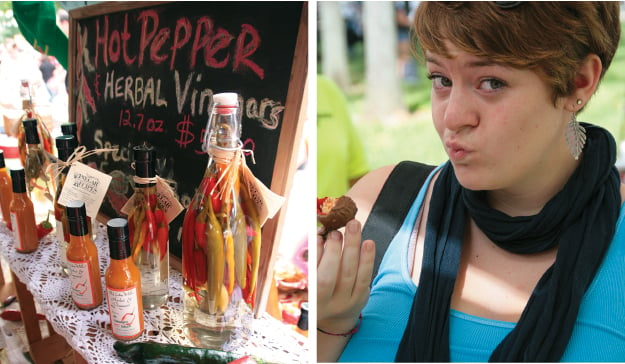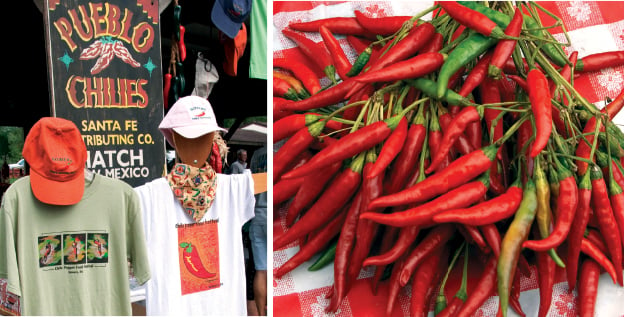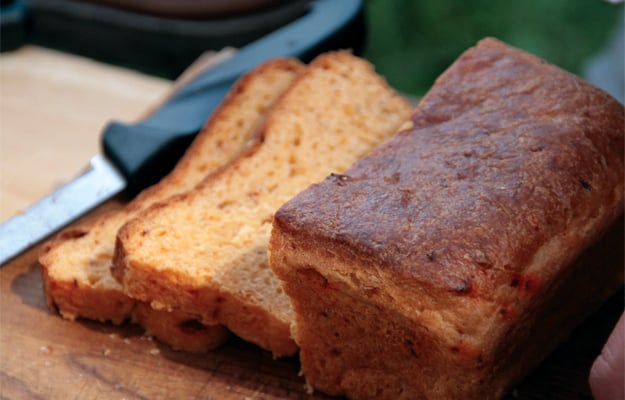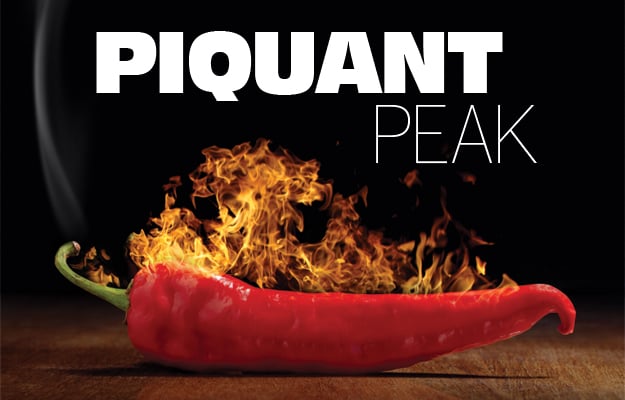
“‘Is it safe?' our friends ask me when they come over,” says Shirley Grumbine of Birdsboro, Pennsylvania. “‘No, it's not safe!' I tell them.” Grumbine is referring to whatever concoction—this year it's BBQ capable of sending your sinuses into orbit—that her husband Tom has just made from hot peppers. The Grumbines, like many of the 10,000 visitors who come to the Chile Pepper Festival in Bowers, spend time out in a field picking peppers.
Every year in September, pepper lovers converge on a tiny town in southeast Pennsylvania to celebrate this volatile vegetable. It's a surprisingly competitive group, both in conversation and in action. Farmer Jim Weaver, who grows the peppers at Meadow View Farm, says every year he gets requests for more extreme peppers. “Everybody still wants to prove ‘I can handle this pepper,'” he observes. “I don't see why it needs to get hotter and hotter. It's got to stop somewhere.”
Lately, people are looking for Bhut Jolokia (ghost peppers) and Trinidad Scorpion peppers, but they're also asking for Butch Ts. Trinidad Scorpion “Butch T” peppers, according to the Guinness Book of World Records, are the hottest peppers in the world—at least this year. The Butch T has off-the-chart fire, with 1,463,700 Scoville heat units of capsaicin. (Habañero peppers range from 100,000 to 350,000 units, plenty hot for most of us.) The more piquance, that is, pungence and pain, the more capsaicin. The more capsaicin, the hotter the pepper, and the higher it ranks on the Scoville scale. The peppers grown at this farm run the full gamut.
Some should come with a warning label. When working with—or just picking—even mildly hot peppers, experts recommend taking precautions like wearing gloves and not touching your eyes. Goggles cover your eyes and a mask goes over your mouth if you're grinding them, because hot peppers can make you cry, sweat, take your voice or your breath away, give you hiccups or even cause temporary blindness. They are some serious peppers. Which is why growing them has drawn a large base of pepper fans to a town so small your GPS may not be able to find it.

The Rise of the Pepper
The Bowers festival's roots lie in one man's education. With a master's in futurology, Chris Markey interprets trends; he predicted the rise of the pepper in North America back in the 1980s. He talked Weaver into planting a half-dozen varieties, and they were on the cutting edge. “Nobody was doing that then,” recalls Markey, at least in Pennsylvania. At the time, Weaver wondered whether it was a fad. But Markey's prophecy proved sound.
Three years later people in the area around Kutztown wanted to buy not just the peppers but also seedlings. They also wanted to know what to do with these hot vegetables technically classified as botanical fruits. Markey decided it was time to educate, so they launched a Field Day. “The rest,” he quips wryly, “is history.”

Today at Meadow View Farm you'll find more than 20,000 tomato plants, most of them heirloom, 25 varieties of eggplants, a plethora of pumpkins, gourds and squash and some 14,000 hot pepper plants. The farm now supplies Wegmans, Trader Joe's and several popular restaurants. A contingent of local customers originally from Liberia, Sierra Leone and Nigeria, who grew up on Scotch bonnet peppers, bring Weaver seeds then drive out each summer to buy every single ripe one he has. Weaver ships them anywhere. “The word is out that I have them,” he says, grinning. “I just got a call from Arizona.”
Half the fun is going out in this field yourself, where you can trade wicked-hot salsa recipes with other pepper aficionados. Row after row is labeled, and some of the names are actually kind of scary. Halfway down the Inferno Hot Banana row, someone from northern India is talking about curry. A few rows over, near the blistering Red Devil's Tongue and Explosive Ignite varieties, pickers are debating which is hotter.

Test Your Palate
Back at the festival, people are busily tasting hot stuff. Unlikely signs announce Hot, Hot Smokin' Chocolate, Hot Peanut Butter Eggs and Peach Mango Habañero Jam. One says “Gourmet Grilled Red Pepper Chipotle Cheese Spread Sandwiches on Chipotle Brioche.” Come lunchtime, the only question is where to start.
Look for the crowds and you're likely to find the festival favorites, but try starting with the less-hot items, in a sort of vertical pepper tasting. Begin with, say, chipotle plum chocolate chip cookies. Move up to hot pepper peanut brittle and then pepper-encrusted corn on the cob. Save the more dangerous fare, chocolate covered cherry peppers or butt kickin' bhut jolokia dip—which you can identify by the RIP sign—for last. Otherwise, you'll compromise your palate.
So say “the pepper men,” who judge the salsa contest. John Bixler, Chris Markey and Jim Weaver are the figures behind the pepper movement in the southern end of Maxatawny Township. While Weaver sticks to farming, Bixler and Markey run the festival and sample every salsa entry. They check the taste, the texture, the heat and even the appearance.

“Some of them are just too hot,” complains Markey. “By the time you've tasted 20 different degrees of heat, the last few are sort of at a disadvantage.” While visitors can't sample the official entries, they can sample and purchase pepper-related items. Aprons, necklaces and even baby clothes decorated with chili peppers make for a bright display, and hot sauces abound. Edible or not, everything at the festival is, at the insistence of the founders, pepper-related.
As 4 p.m. on Saturday rolls around, a new energy is palpable. It's time for the pepper-eating contest. Festival-goers crowd around to watch this group of (possibly crazy) competitors. It's the kind of spectacle you don't think you want to witness, like a car wreck, but you can't help looking. And it is entertaining, in its way.
Ten at a time, in three shifts, this year's batch of pepper-hungry contestants line up in front of paper plates piled with jalapeño peppers. They come armed with their own liquid heat quencher. Rumored to help the most is milk, so regular and chocolate milk put in a strong showing, along with water and an occasional OJ.
The official bell rings and they're off. It's not pretty, watching the contestants' faces contort as they try to swallow each bite quickly. Fortunately, the painful scene doesn't last long. Soon the deliberation begins. Last year the winner was a woman. This time, it's a local man by the name of Travis Boyer, who walks away with the official trophy.
Once the contest is over, the crowd begins to disperse on this, the second and final day of the festival. Some amble by cars with dragonfirehotsauce.com stickers or past the table with the spicy red-hot Thai curry orzo. A few join the dwindling line for the last horse-drawn wagon run over to the farm. A red-haired toddler in overalls cries as his stroller gets packed into an SUV. It's time to say goodbye to the peppers for another year. Good thing. It's been a long, hot day.
Try something wild! Here are a couple recipes sure to add a kick to your next tailgate party.

Fire-Roasted Red Pepper Cheese
Makes about 3 cups
½ cup fire-roasted red bell pepper, minced2 Chipotle peppers in adobo sauce½ cup minced green onion, white and pale green portion2 cloves of garlic, peeled and minced8 ounces aged sharp Cheddar cheese, grated4 ounces medium Cheddar cheese, grated4 ounces Monterey Jack cheese, grated½ cup mayonnaise (not Miracle Whip)2 teaspoon Dijon mustard1 teaspoon Tabasco sauce1 teaspoon smoked Spanish paprika1 Tablespoon fresh lemon juicePinch of cayenne pepper½ teaspoon salt
In a processor fitted with the steel blade, pulse the bell pepper, chipotle, green onion and garlic until chopped/chunky but not finely minced. Grate cheese. In bowl combine remaining ingredients. Mix gently with the cheese until thoroughly combined. Add a little more mayonnaise if it's too runny. Spread on Chipotle Brioche and grill.

Chipotle Brioche
Makes two, 8 ½ x 4 ½-inch loaves or six, 5 ½ x 3 ½-inch loaves.
1/3 cup warm water1/3 cup warm milk2 envelopes active dry yeast¼ teaspoon of sugar3 ® cups all purpose flour2 teaspoon salt3 large eggs (room temperature)¼ cup sugar3 chipotle peppers in adobo sauce, chopped fine3 sticks salted butter at room temperature
Heat the milk and the water together until warm on the wrist, but not hot; add yeast and place in the bowl of a standing heavy-duty mixer fitted with the dough hook. Add sugar and stir until the yeast and sugar dissolve. Let proof for 10 minutes, until bubbly. Add flour and salt; mix on low speed just until flour is moistened, about 1-2 minutes. Stir well and scrape bowl to make sure everything is moistened. Beat in eggs, one at a time, on low, then add ¼ cup sugar.
Crank speed up to medium, and beat until dough comes together, about 3 minutes. Add peppers, then begin adding butter, two tablespoons at a time, beating each time to incorporate well. Dough will become goopy and runny. Increase mixer speed to medium-high for 10 minutes. Dough will begin pulling away from the sides of the bowl (keep away from edge of counter, as this will become a bit violent). Transfer dough into a clean bowl and cover with plastic wrap. Let rise at room temperature until almost doubled in volume, about 1 hour. GENTLY punch dough down to deflate it and let it rise again for ½ hour. Do this 4 times (2 hours in total). After the final rise, punch down, cover with plastic wrap and chill in refrigerator overnight or for 6-8 hours.
The next day, butter and flour 2 large loaf pans (8 ½ x 4 ½ inches). Remove dough from bowl and flatten it into a large rectangle; divide in half. Dough will be stiff but still very pliable. Press gently into loaf pans, filling all the corners, and cover loosely with plastic wrap; let dough rise to top of pans. Preheat oven to 400°F and bake until golden brown and hollow-sounding when tapped, about 30-35 minutes. Cool to room temperature, then turn out onto rack. (May be wrapped airtight and frozen for up to 2 months).
Hoppin' Jalapeño Carrot Cake >>
text & festival images by cindy kalinoski



.jpg.jpe)
.jpg.jpe)











